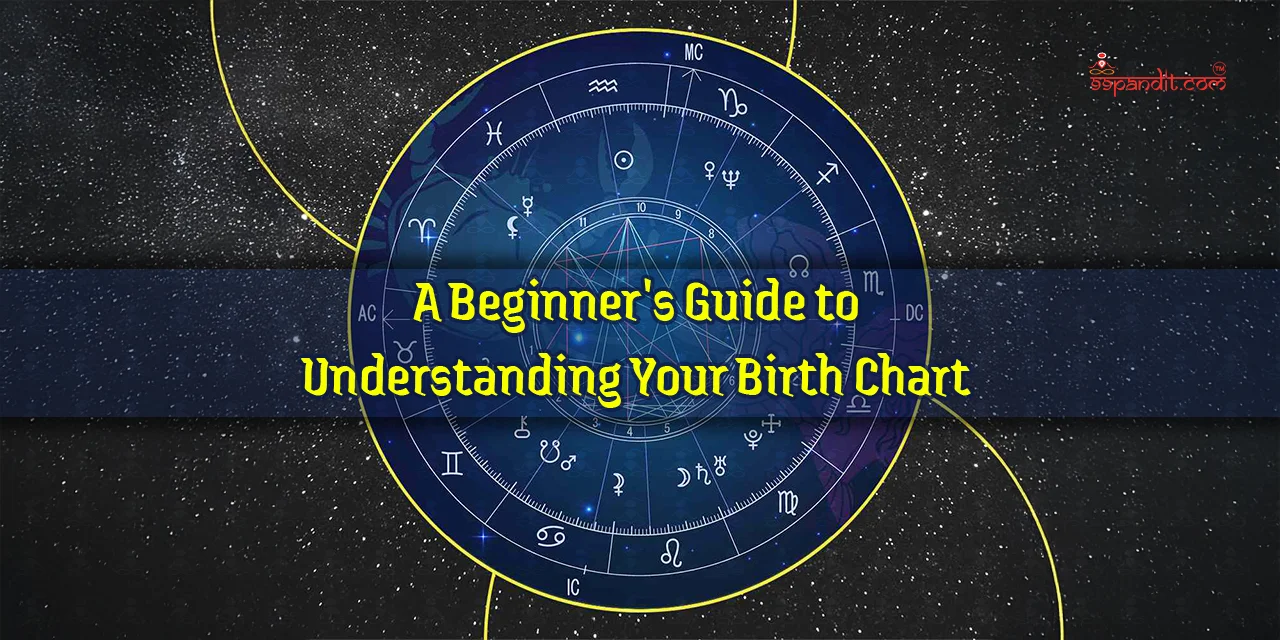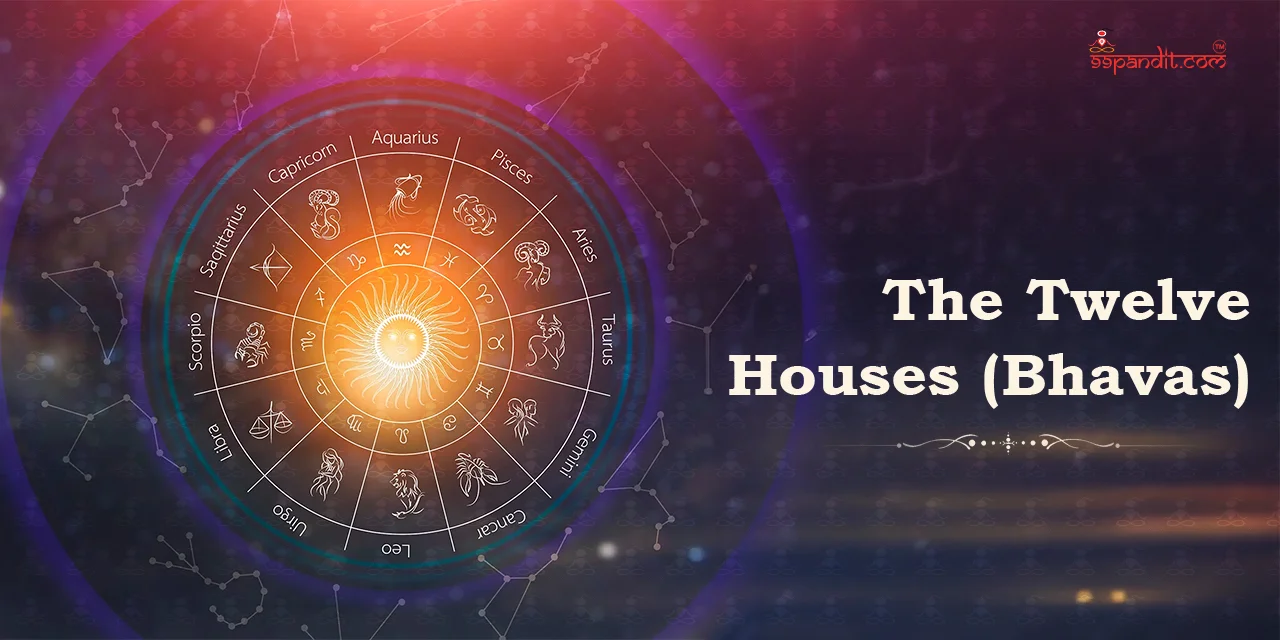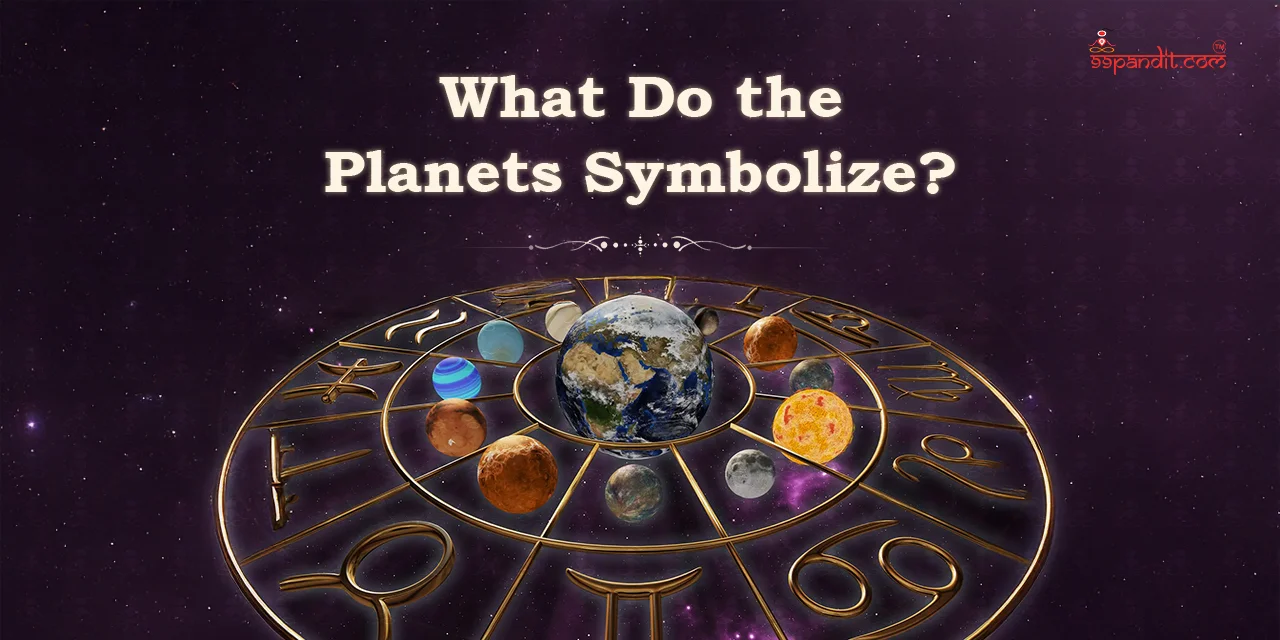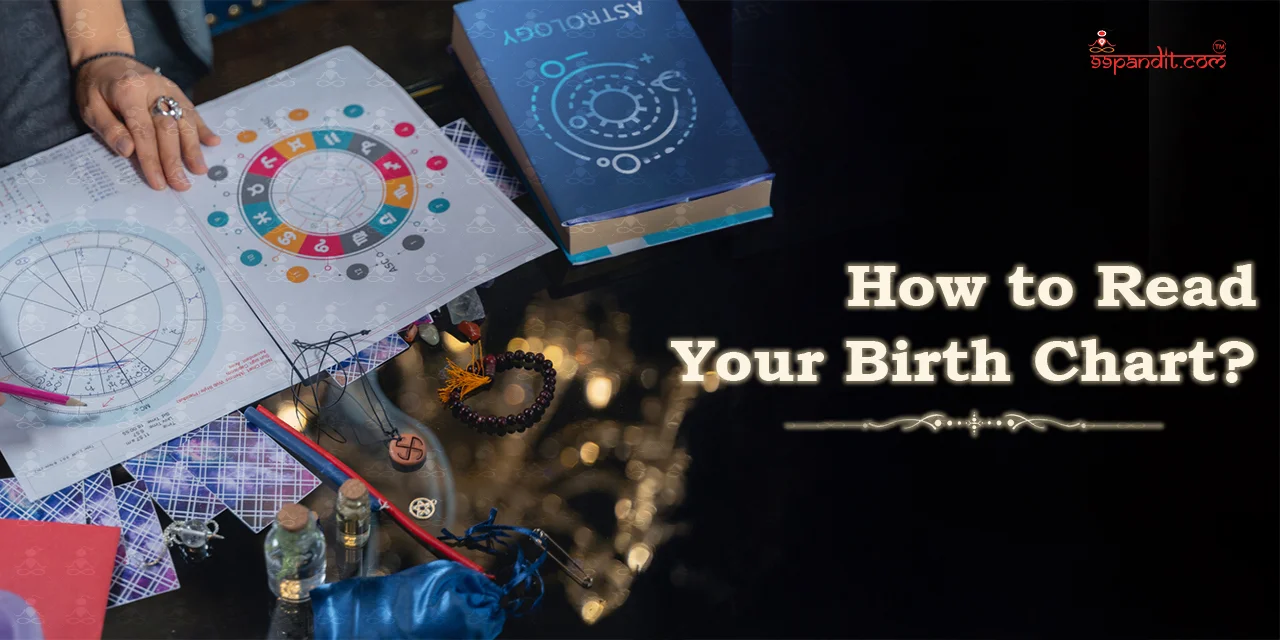What Are Rising Signs? How They Affect Personality and Life
Our Rising Signs show how we appear to the world. In Vedic astrology, they tell us the natural energy we…
 0%
0%

How to Read a Birth Chart: Are you always keeping a close eye on the ‘Daily horoscope’ section? Would you not like to get the most essential information into your life, present and future?
You’re on the right track to know the variations of the Vedic birth chart. Why wait? Let’s read the article to learn about the birth chart in detail.
A birth chart is the representation of the stars’ location and planetary positions at the moment you were born.

The mapping of stars and planets represents a Janam Kundali, or we say Birth chart. But reading it does not seem easy, yet. Considering the details of birth date, time, and place helps to create a birth chart.
A birth chart consists total of 12 zones, or we say houses, to identify an individual’s life challenges. Similar to your zodiac sign, each house shows your life characteristics.
Still, the doubt is to know the way how to read a birth chart. A good analysis of a kundali finds the planetary placements in the sky at the time of your birth.
Analysing the chart, called the natal chart, offers deep details about your personality, motivations, and desires.
Let’s see the practice of astrology and the creation of reading birth charts, and how you can apply it to your life.
A Vedic birth chart is the mapping of the sky at the accurate moment and your birthplace. The positions of planets, constellations, and zodiac signs are described in a birth chart.
But it uses a tropical zodiac unlike Western astrology. Vedic astrology implements the sidereal zodiac, catering to fixed star positions and showing cosmic reality more efficiently.
The birth chart is created using three critical data points:
A celestial fingerprint – a karmic map displaying your strengths, weaknesses, relationships, and spiritual path.
Using it, ancient seers considered that Dharma (aim), Artha (wealth), Kama (desires), and Moksha (salvation) could all be maintained.
There are three main elements to interpret a birth chart: the planets, the signs, and the houses.
A birth chart will indicate a snapshot of where all planets are in the sky, but within the map, the sky would be categorized into 12 equal parts for the 12 zodiac signs.
Hence, each planet will fall within a specific zodiac sign. For example, there will be a Sagittarius Venus if Venus falls within the Sagittarius slice.
The sky will then be split into 12 houses, with every planet falling within a certain house.
Hence, while everyone will have similar planets in their charts, they typically won’t be in the same zodiac signs or houses, offering everyone their unique chart.
Ascendant or Lagna is the first component, which is the zodiac sign happening on the eastern horizon at your birth.
Usually thought to be more important than your sun sign, the lagna works as the filter through which each planet’s energies flow and impact your personality, decisions, and how others sense you.
For example, for Radhika, who is a school teacher from Pune, a detailed reading of her chart shows a Virgo lagna – one that mentions her analytical mind, nurturing temperament, and deep wishes to help others.
The single information transformed her view of earlier career uncertainties into spiritual powers.

All Vedic charts include twelve ‘houses’ that show elements of life:
Vedic astrology thought nine planetary impacts or grahas, each carrying divine archetypal energy:
There are a total of 12 zodiac signs from Aries to Pisces, all with their own elemental characteristics and impacts on planetary influences.
Every sign consists of specific qualities and goals. For instance, Leo represents leadership and radiance, while Pisces represents spiritual unravelling and empty.
Hidden deeper still are the nakshatras, 27 lunar constellations that design Vedic readings with granular information.
A planet positioned in Rohini Nakshatra, for instance, usually bestows beauty and innovative talent, while Ashlesha advises emotional intensity and kundalini strength.
While Astrology is a huge, complex, and highly expertise study, the basic principles are simple. A birth chart is a presentation of the sky at the moment of your birth.
It shows precious star and planet location and which star they occupied as you entered the world.

In some birth charts, every planet is in the same constellation; in others, they’re spread widely in the sky.
The distance between these planets is essential as each has its own celestial features. Let’s understand each planet in the sky:
When someone asks about your sign, whether or not they know it, they’re asking about the placements of the sun during your birth time.
The sun shows our fundamental importance. The vibrant celestial body shows our ego, sense of self, basic personality, and general suggestions.
The sun is ruled by the zodiac sign of Leo, a dynamic fire sign that oozes both bravery and theatricality.
The gravitational powers of the moon regulate the climate and ocean tides. In astrology, the moon shows our emotional inner world.
As the sun exposes our outer experience, the moon symbolizes everything emotional beneath the surface.
The star is governed by Cancer, the sensitive, protective water sign that describes nature, comfort, and safety.
Mercury is the smallest and inner planet of the solar system. It is called after the Roman goddess who was a messenger of gods.
The planets depict reasoning and logic when the moon portrays our feelings. It is governed by both Gemini and Virgo, and each of them exhibits a variant of the expression of Mercury.
A vibrant planet that expresses beauty, love, and abundance. Both Taurus and Libra are ruled by Venus, and all of it defines different sides of Venus’s expression.
It takes around four to five weeks to transit a zodiac sign and goes retrograde every 18 months.
The red planet is called the fighter of the zodiac. It symbolizes action, determination, and aggression.
Mars takes around six to seven weeks to transit a zodiac sign and goes retrograde every two years.
We may have trouble standing up for ourselves or seeing a lack of motivation in the bedroom when it goes retrograde.
The largest planet of the solar system is Jupiter. Greek mythology is recognized for its colossal presence.
This is the lucky planet that expresses fortune, philosophy, abundance, and spirituality.
The ringed gas giant is connected with time, regulation, and restrictions. Saturn is associated with good work, professional achievements, and steadfast resilience on a good day. But on a good day, it could be harsh and unemotional, forcing us to learn through a tough time.
The first planet found by a telescope, the only celestial body named after a Greek deity. It’s tilted far on its axis, which importantly orbits the sun on its side.
The planet represents technology, rebellion, and innovation. Facilitate groundbreaking, dynamic change.
Neptune energy is an extremely creative and powerful psychic on a good day. But on a bad day, it can become delusional and escapist. When the planet effect is felt, discover your imagination and psychic powers.
It transits each sign in around 14 years and goes retrograde every year for around 150 days. Do not try to get away with the duplicitous behaviour of Neptune when it’s retrograde.
The icy celestial body of Pluto didn’t track up to the astronomical definition of a planet, according to the astrological standards.
The planet represents power, transformation, destruction, and recreation. Associated with Scorpio, the planet is defined by its mysterious disposition.
Before delving into the complexities of a Vedic birth chart, it’s important to gather exact details of the one in question. The three main components required are:
The accurate birth time, birth date, and location are important to build the correct chart.
This information acts as the core for calculating the placements of planets and creating a custom birth chart.

Whether the birth time is accurate or not obviously affects the accuracy of astrological analysis.
Therefore, attempt to get the best details as you can. For example, see the image below to understand the concept better.
Create your birth chart using a reliable online Vedic astrology platform or by contacting a professional astrologer. Make sure it uses sidereal, not tropical, calculations.
The lagna, also called the rising sign, is an important part of the chart and sets the tone for one’s entire personality.
Being an important component, it shows a rising symbol on the eastern horizon at birth.
The lagna sets the way for the complete birth chart, impacting personality, physical appearance, and overall life path.
To know the lagna, see the birth chart and find the sign rising on the leftmost side, usually called the first house.
As discussed before, the 12 houses of the horoscope correspond to different areas of life, like career, relationships, health, and spirituality.
On the other hand, planets show various cosmic energies that impact these elements. All planets have their characteristics and affect the house they contain.
It’s required to study and know the importance of each house and planet to interpret the birth chart exactly.
For instance, the sun defines the self, the moon defines emotions, and Jupiter is linked with wisdom and knowledge.
Are specific planets elevated, such as the Moon in Taurus and Jupiter in Cancer? Do they influence each other, creating harmony or stress? These give high information into the phases of life, challenges, and spiritual growth potential.
According to Vedic astrology, yogas are particular combinations of planetary positioning that can bestow multiple unique qualities or challenges based on the individual.
On the other side, doshas like kaal sarp dosha or mangal dosha show potential challenges and problems in different aspects of life.
Being aware of such yogas and doshas makes the analysis more meaningful and enables astrologers to provide specific guidelines in personal development and health.
When you’re aware of detailing, studying, and making the birth chart, the final step consists of making predictions depending on horoscope analysis.
Astrologers use many techniques, like doshas and transits, to forecast certain events in one’s life.
Apart from these, other remedial measures include gemstone preferences, mantra chanting, and significant rituals to remove challenges and improve positive energies.
These are the details a beginner should know before reading their birth chart. Reading a birth chart might seem complicated at first, but practising it becomes an enlightening experience.
Your chart keeps the key to know yourself better, making informed decisions in life, and aligning with your true purpose. Start knowing today, and let the stars guide your journey!

100% FREE CALL TO DECIDE DATE(MUHURAT)

Table Of Content
Filters by categories
All Pujas
Puja On Special Events
Upcoming Pujas
Dosha Nivaran Pujas
Mukti Karmas
Filters by Trending Topics
Filters by Regions
North Indian Pujas
South Indian Pujas